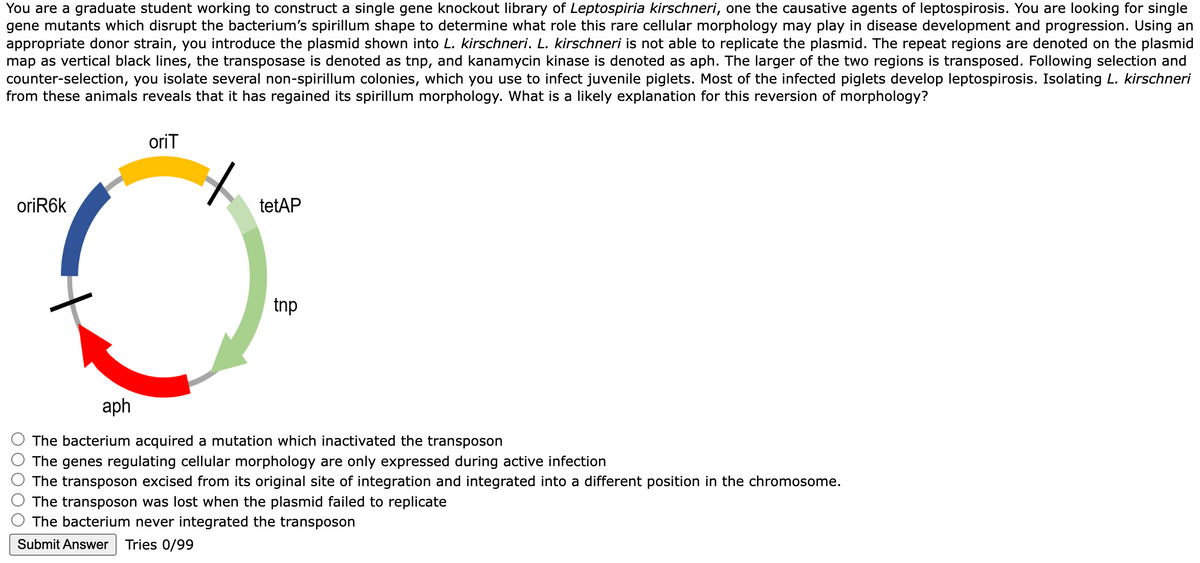You are a graduate student working to construct a single gene knockout library of Leptospiria kirschneri, one the causative agents of leptospirosis. You are looking for single gene mutants which disrupt the bacterium’s spirillum shape to determine what role this rare cellular morphology may play in disease development and progression. Using an appropriate donor strain, you introduce the plasmid shown into L. kirschneri. L. kirschneri is not able to replicate the plasmid. The repeat regions are denoted on the plasmid map as vertical black lines, the transposase is denoted as tnp, and kanamycin kinase is denoted as aph. The larger of the two regions is transposed. Following selection and counter-selection, you isolate several non-spirillum colonies, which you use to infect juvenile piglets. Most of the infected piglets develop leptospirosis. Isolating L. kirschneri from these animals reveals that it has regained its spirillum morphology. What is a likely explanation for this reversion of morphology?' A. The bacterium acquired a mutation which inactivated the transposon B. The genes regulating cellular morphology are only expressed during active infection C. The transposon excised from its original site of integration and integrated into a different position in the chromosome. D. The transposon was lost when the plasmid failed to replicate E. The bacterium never integrated the transposon
Bacterial Genomics
The study of the morphological, physiological, and evolutionary aspects of the bacterial genome is referred to as bacterial genomics. This subdisciplinary field aids in understanding how genes are assembled into genomes. Further, bacterial or microbial genomics has helped researchers in understanding the pathogenicity of bacteria and other microbes.
Transformation Experiment in Bacteria
In the discovery of genetic material, the experiment conducted by Frederick Griffith on Streptococcus pneumonia proved to be a stepping stone.
Plasmids and Vectors
The DNA molecule that exists in a circular shape and is smaller in size which is capable of its replication is called Plasmids. In other words, it is called extra-chromosomal plasmid DNA. Vectors are the molecule which is capable of carrying genetic material which can be transferred into another cell and further carry out replication and expression. Plasmids can act as vectors.
You are a graduate student working to construct a single gene knockout library of Leptospiria kirschneri, one the causative agents of leptospirosis. You are looking for single gene mutants which disrupt the bacterium’s spirillum shape to determine what role this rare cellular morphology may play in disease development and progression. Using an appropriate donor strain, you introduce the plasmid shown into L. kirschneri. L. kirschneri is not able to replicate the plasmid. The repeat regions are denoted on the plasmid map as vertical black lines, the transposase is denoted as tnp, and kanamycin kinase is denoted as aph. The larger of the two regions is transposed. Following selection and counter-selection, you isolate several non-spirillum colonies, which you use to infect juvenile piglets. Most of the infected piglets develop leptospirosis. Isolating L. kirschneri from these animals reveals that it has regained its spirillum morphology. What is a likely explanation for this reversion of morphology?'
A. The bacterium acquired a mutation which inactivated the transposon
B. The genes regulating cellular morphology are only expressed during active infection
C. The transposon excised from its original site of integration and integrated into a different position in the chromosome.
D. The transposon was lost when the plasmid failed to replicate
E. The bacterium never integrated the transposon

Trending now
This is a popular solution!
Step by step
Solved in 2 steps









